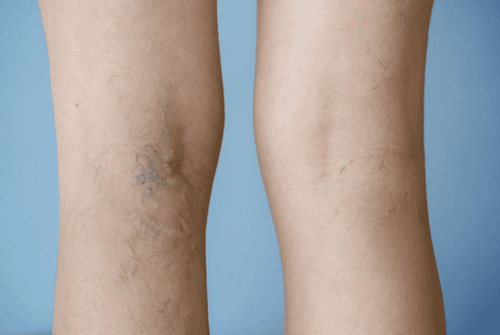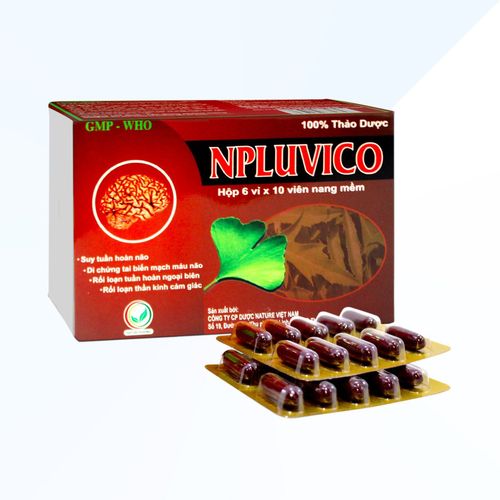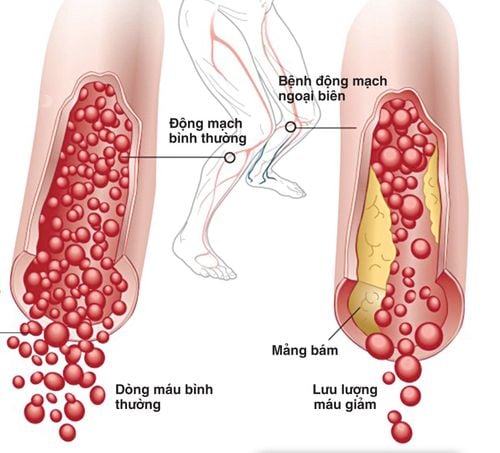This is an automatically translated article.
The article was professionally consulted with Master, Doctor Pham Van Hung - Department of Medical Examination & Internal Medicine - Vinmec Da Nang International General Hospital.Lower extremity artery disease occurs when plaque builds up in the arteries and blocks blood flow. Early diagnosis and treatment of lower extremity artery disease will reduce the risk of cardiovascular events, improve symptoms in the legs as well as improve the quality of life for patients.
1. What is lower extremity artery disease?
Lower extremity artery disease, also known as peripheral artery disease, occurs when plaque forms in the arteries of the lower extremities, blocking blood flow. Atheroma consists of fat, cholesterol, calcium and other substances in the blood. When these plaques accumulate, they block completely or partially, narrowing the arteries, and restricting blood flow to tissues in the legs and other parts of the body. This is sometimes called hardening of the arteries or atherosclerosis.Because of poor blood circulation, the patient can suffer from foot pain and increase the risk of developing open sores and skin infections. Left untreated, lower extremity artery disease can progress to necrosis of leg tissues, sometimes requiring amputation.
2. What are the signs and symptoms of lower extremity artery disease?
Lower extremity artery disease usually affects only one leg. The most common and noticeable symptom is leg pain after walking a short distance (distance length varies from person to person but generally not far), this is known as claudication.The cause of lower extremity pain when walking is due to insufficient blood and oxygen flow to the lower extremity muscle organization during physical activity. The pain tends to occur in the same area of the leg, such as the calf, whenever the person walks and relieves pain after resting for a few minutes. When walking is started, the pain tends to reappear at a distance equal to the distance walked.
In addition, signs of lower extremity artery disease include:
The appearance of sores on the legs or feet. Sometimes these lesions arise from an injury or minor scratch. Poor blood circulation in the legs can lead to dry, cracked skin. Because small cuts and cracked skin don't get enough blood flow to regenerate, bacteria can get into them and cause an infection. If the sore becomes infected and left untreated, the tissue can die. This condition, called gangrene, occurs when a blocked artery prevents leg tissue from receiving enough blood and oxygen. A severely necrotic leg may require amputation if surgical treatment and medication fail to restore effective blood flow. Signs of limb necrosis include discolored, foul-smelling skin and discharge from the infection.

3. Factors that increase the likelihood of lower extremity artery disease
Lower extremity artery disease is often caused by smoking, obesity, and poor nutrition. People with high blood cholesterol levels due to genetic factors or a high-fat diet can cause clogged arteries. Besides, a sedentary lifestyle also increases the risk, because of poor blood flow. So, regular exercise has been shown to improve blood flow and artery health.Hypertension is another risk factor. High blood pressure damages the artery walls, making them more susceptible to blockage and narrowing. In addition, patients with diabetes are also more likely to develop lower extremity artery disease because of the easy formation of atherosclerotic plaques that block the arteries.
4. Tests to diagnose lower extremity artery disease
After examining and reviewing your medical history, your doctor may order one of the following tests to look for signs of a blockage in your lower extremity arteries.Color Doppler Ultrasound A color Doppler ultrasound uses sound waves to create images that highlight blood flow in the arteries of the lower extremities. This tool detects and evaluates any blockages caused by plaque buildup.
During an ultrasound, the doctor places a hand-held device (transducer) on the skin, which transmits sound waves that create an image of the blood vessels in the leg on a screen. This process can take 30 to 60 minutes and shouldn't cause any pain. After that, the patient can completely return to their usual activities.
Measure blood pressure in extremities Doctors can measure blood pressure in thighs, calves and feet as well as blood pressure in arms. Low blood pressure can be a sign of an artery blockage with insufficient blood flow.
Computed tomography During computed tomography, X-ray technology is used to examine many structures inside the body. Before the scan, the patient is given an intravenous dose of contrast material, which passes through the blood vessels and highlights any blockages in the arteries of the lower extremities.
Angiography In angiography, X-rays are also used to determine if plaque is blocking a blood vessel. During the procedure, the patient is under local anesthesia, the doctor will make a small incision in the skin near the groin, insert a catheter and guide the femoral artery. The doctor continues to move the catheter to the area of the leg to examine and inject a contrast medium to highlight the vessel lumen, detecting narrowing, dilation, or blockage of the lumen.

5. How is lower extremity artery disease treated?
5.1. Medical treatment Doctors prescribe medications to control high blood pressure, cholesterol levels, and diabetes, all of which can contribute to lower extremity artery disease.Drug use requires lifelong compliance. Other treatments for lower extremity artery disease include lifestyle changes and minimally invasive surgery.
5.2. Surgical treatment When lifestyle changes and medications do not prevent or relieve symptoms of painful lower extremities, your doctor may recommend surgery to remove blockages and prevent new masses from forming, including These include the following:
Endothelial dissection Most people with lower extremity artery disease are successfully treated with endarterectomy. This procedure involves cleaning the clogged artery by scraping or cutting the plaque.
Before the procedure begins, the patient is given local anesthesia and light sedation. Then contrast dye is injected so the doctor can see the blockage on the X-ray. The surgeon inserts a catheter into the femoral artery, into the blocked artery, and removes the plaque using an endovascular instrument attached to the tip of the catheter.
In some cases, the surgeon may perform other procedures at the same time, such as balloon angioplasty and stenting to prevent future blockages.
Angioplasty and stenting Endothelial dissection is not always possible, while balloon angioplasty and stenting, a metal mesh tube is inserted into the blood vessel to hold it. open, somewhat simpler.
The patient needs only local anesthesia. During balloon angioplasty, the doctor will push the balloon through the catheter to the narrowed blood vessel and then inflate the balloon. After that, the doctor continued to place the stent in place, maintaining the ability to improve blood flow long-term after the intervention.
Bypass Surgery Angioplasty and stenting may not be the best surgical treatment for people with diffuse arterial blockages as well as other health problems, such as blocked arteries. intermittent pulse, painful lower extremities when walking, diabetic gangrene, open sores on legs or pulmonary embolism... life-threatening.
Instead, the doctor may consider bypassing surgery, which allows a "new route" for blood to bypass the blocked artery, restoring blood flow to the leg. The greatest benefit of bypass surgery is that the amputation of the leg because of gangrene can be avoided.
Lifestyle changes Eating healthy and exercising regularly can reduce your risk of developing lower extremity artery disease. These habits can also help prevent the disease from coming back if treated.
Some bad habits and health problems can put a strain on the heart, such as smoking, obesity, high blood pressure and uncontrolled diabetes. All can lead to a buildup of atherosclerotic plaque in the arteries of the lower extremities - the leading cause of lower extremity artery disease.

Currently, Vinmec International General Hospital is a medical unit equipped with a Hybrid room system. Hybrid operating room at Cardiology Center is equipped with state-of-the-art equipment such as DSA angiography machine, anesthesia machine with the most closely integrated patient hemodynamic monitoring software (PiCCO system, entropy, . ..). Therefore, the Hybrid operating room can meet the requirements of surgery and angioplasty, coronary stenting, aortic stent graft, open heart surgery, heart valve replacement for congenital heart diseases with modern minimally invasive techniques. most invasive, safe, help patients recover health soon.
Please dial HOTLINE for more information or register for an appointment HERE. Download MyVinmec app to make appointments faster and to manage your bookings easily.
Reference sources: uptodate.com, nyulangone.or, escardio.org, vnha.org.vn













